
views
Assessing Your Turnout
Find a professional. Since incorrect turnout can damage muscles and lead to knee problems, it's important that you work on your turnout with a professional ballet teacher. Try to find a pre-professional ballet school that is associated with a professional ballet company. This way, an instructor can give you individual attention, helping you achieve the perfect turnout. If you can't find an experienced ballet teacher, try to find an advanced ballet dancer at your studio. They may be able to offer some free advice since taking private lessons with professional ballet teachers costs more than just group lessons. Some may only teach private lessons for more advanced students and group lessons for less advanced. However, if you just want a few tips, ask before class starts if your teacher has time after class, and stay after class so they can give you a few corrections and pointers on your turnout.
Since the muscles of young ballet dancers are still developing, it's easier to improve flexibility when you're young (before age 12).
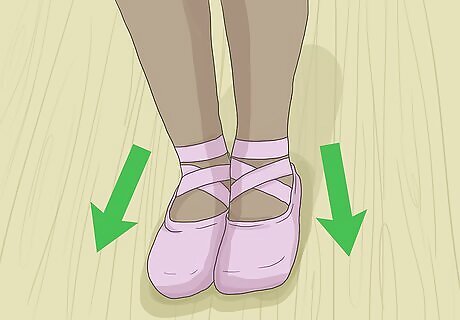
Get ready to turnout. Before you turnout, stand in front of a mirror with your feet touching and facing forward in a parallel position. Make sure your tailbone is pointed down, not pushed out and back. Stand firmly on your feet. Check in the mirror if you're pulling up on your quadriceps and pushing your shoulders downwards with good posture. If you're too tense when you begin to turnout, you're more likely to cause muscle strain and injury. Spend at least 10 minutes stretching your leg and hip muscles before dancing.
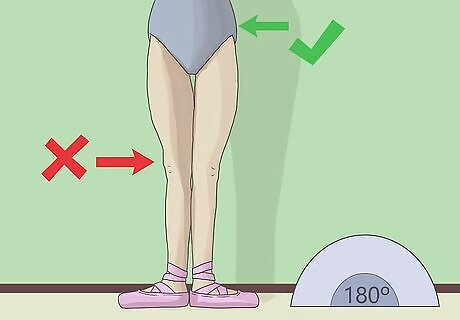
Get in position. Once you're in the correct position, lift your toes up and away from each other (in opposite 90 degree angles). It is critical that you do not simply twist your feet away by using your knees and lower legs. Instead, shift your weight to your hips so that your feet naturally move apart. Make sure you're not putting all your weight on your big toes instead of distributing it throughout your feet. The ideal turnout is 180 degrees. Don't worry if you can't turnout that much. Stretching can improve your flexibility by a few degrees. Good turnout also means that you're honest about what your natural turnout is and don't try to force it. Make sure your weight is evenly distributed throughout your foot. Poor turnout puts strain on just your big toes and rolls your feet in. Instead, your feet should be level with the ground.
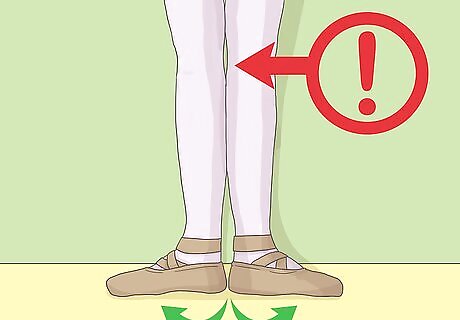
Avoid forcing your turnout. While it may seem easy to use your knees in order to spread your feet farther apart, do not do it. This will strain your knees and legs. Research shows that this causes poor alignment and can lead to injury. Turnout should feel like a natural stance. You shouldn't feel any strain in holding it while in any position. If you continue to practice poor turnout, you'll begin to feel knee pain and muscle ache. The strength for your turnout should come from your core, inner thighs, and bottom. It's easiest to force your feet when you're in the 5th position. But, you should always be on guard against improperly rotating out your feet.
Stretching to Improve Turnout
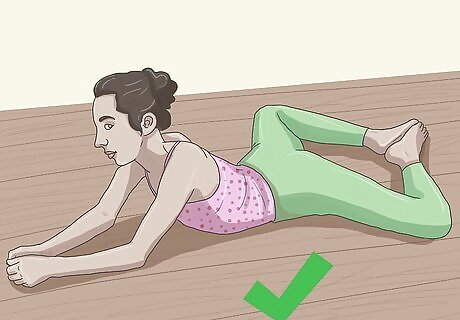
Practice the frog. Lay on your stomach while resting on your elbows and forearms. Move your feet together. The knees should be pointing out so that you make a diamond. Your feet should be touching and remain on the floor. Breathe and hold the position for 3 to 6 breaths. Do as many reps as you comfortably can. The frog stretch can open your hips, groin and inner thigh muscles. To properly stretch your muscles, keep your bottom on the floor (not raised up in the air). You can also put your feet in first position, then do small kicks with your back leg. That will help strengthen your muscles in your bottom, thighs, and stomach.
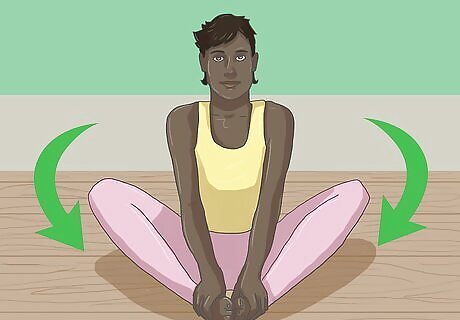
Do the butterfly. Sit on the floor and place your feet together so that your ankles rotate out in a diamond shape. Hold your feet with your hands and sit up straight. Try to bring your ankles down to the ground so that your hip opens up. Hold the pose for 30 seconds at a time and repeat it as often as you feel comfortable. The butterfly stretch can improve the muscles of your hips, groin, and inner thigh which can all make you more flexible. It may help to have someone slowly push down on your knees for maximum flexibility.
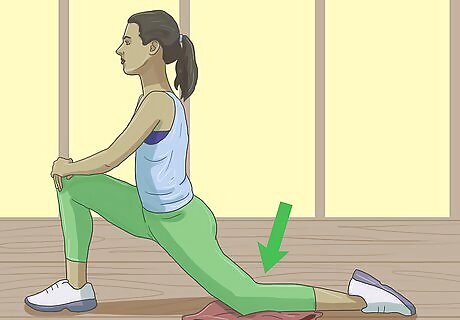
Do a lunge stretch. Kneel and set a pillow under one of your knees. Keep both of your legs turned in and lunge forward with the knee that doesn't have the pillow under it. Lunge until your knee makes a 90 degree angle and rest your hands on your knee. Keep pushing till you feel a slight stretch and hold for 15 seconds. Repeat this 3 or 4 times. Then do it with the opposite knee. You should keep your hips level and make sure your tailbone doesn't stick out. Your back should be straight. Lunge stretches can improve your hip rotation, making turnouts easier.
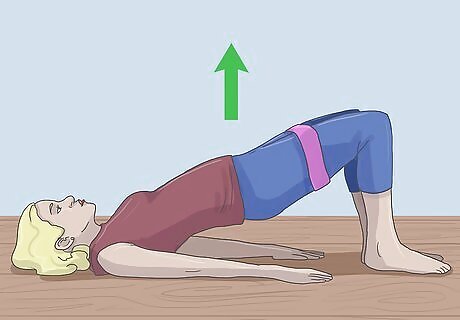
Do the bridge stretch with an elastic band. Lay on your back and keep your knees together and bent. Wrap an elastic band (like a theraband) around your thighs. Slowly lift your pelvis and back up so that they align with your wrapped thighs. Slowly bring your spine back to the ground. This stretch can strengthen your hamstrings, back, and bottom. You can also do this with one leg crossed over the other, so that one thigh rests on the other. This will challenge you to keep your pelvis aligned with your thighs.
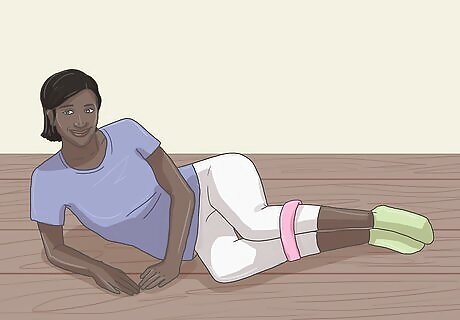
Stretch on your side with an elastic band. Lay on your side so that your knees are bent and one rests on the other. Rest an elbow on the ground so you can sit up a bit. Wrap an elastic band (like a theraband) around your mid-thigh. Rotate your top leg out and in, 10 to 15 times. Repeat this with the other leg until the leg muscles feel relaxed. Avoid doing this stretch too many times or you could injure your muscles.
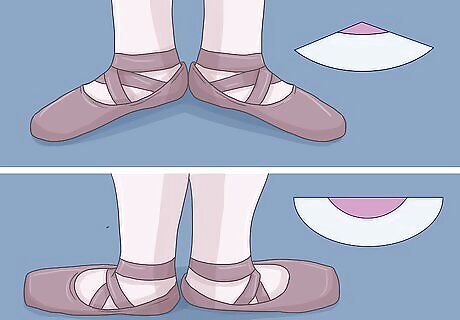
Keep practicing. Stretching can improve your turnout, but it will take time. Stretch and practice your turnout every day. This can gradually help your muscles loosen and stretch more, giving you a bigger turnout. While it's best to start young, regular practice can still improve your flexibility. The American Ballet Theatre National Training Curriculum says that stretches like the lunge stretch can improve your turnout by a few degrees.
















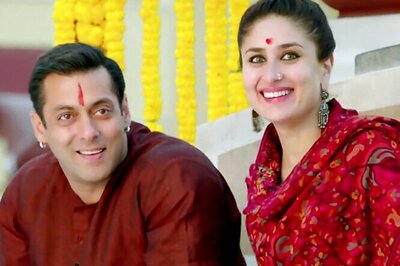
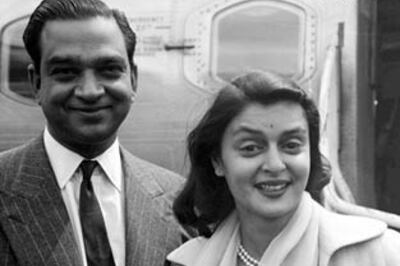


Comments
0 comment